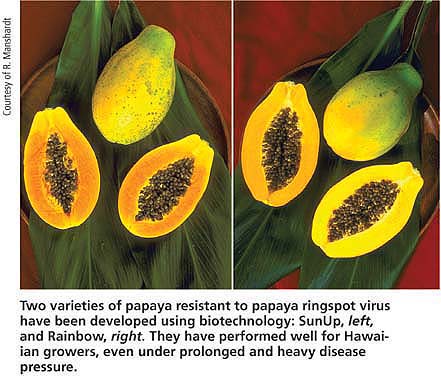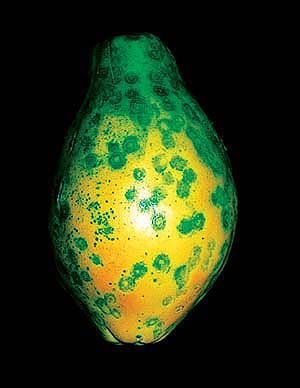All Issues
Sidebar: Virus-resistant transgenic papaya helps save Hawaiian industry
Publication Information
California Agriculture 58(2):92-93.
Published April 01, 2004
PDF | Citation | Permissions
Full text
The pivotal year in the history of Hawaii's papaya industry was 1992. In May 1992, papaya ringspot virus (PRSV) was discovered in Puna on Hawaii Island, where 95% of Hawaii's papaya was being grown. Just one month earlier, a small field trial to test the resistance of a transgenic papaya line had been started on Oahu Island, where papaya production had previously been devastated by PRSV. The timely commercialization of PRSV-resistant transgenic papaya trees has revived Hawaii's papaya industry and provides an example of the challenges and opportunities for horticultural biotechnology.
In 1945, D.D. Jensen made the first report in Hawaii of PRSV, a potyvirus that is transmitted nonpersistently by aphids (Gonsalves 1998). PRSV was first discovered on Oahu and caused such severe damage that the papaya industry was relocated to Puna in the late 1950s and early 1960s. The papaya industry expanded and prospered in Puna, primarily because PRSV was absent. However, by the 1970s PRSV was found only about 19 miles away in Hilo, and the Hawaii Department of Agriculture (HDOA) took rouging (the removal of infected trees) and quarantine actions to prevent its spread to Puna. In 1986, efforts were initiated to develop a virus-resistant transgenic papaya by transforming commercial lines of Hawaiian papaya with the coat protein gene of PRSV from Hawaii.
By 1991, the team of Maureen Fitch, Jerry Slightom, Richard Manshardt and Dennis Gonsalves identified a transgenic line (55-1) that showed resistance under greenhouse inoculations. These plants were micropagated and established in a field trial in Waimanalo on Oahu in April 1992. By December 1992, it was evident that line 55-1 was resistant under field conditions. From the 1992 field trial, two cultivars were developed and designated ‘SunUp’ and ‘Rainbow‐. ‘SunUp’ is homozygous for the coat protein gene while ‘Rainbow’ is an Fl hybrid of ‘SunUp’ and the non-transgenic ‘Kapoho’. Unfortunately, by October 1994, PRSV had spread throughout much of Puna, causing HDOA to abandon rouging efforts to slow the spread of PRSV. The race was on to move the transgenic papaya line to commercialization. A 1995 field trial in Puna conclusively showed that ‘SunUp’ and ‘Rainbow’ were resistant under prolonged and heavy disease pressure.
The U.S. Department of Agriculture's Animal Plant Health Inspection Service (APHIS) deregulated transgenic line 55-1 in November 1996, and the U.S. Environmental Protection Agency deregulated it in August 1997. The consultation process with the U.S. Food and Drug Administration was completed in September 1997. Licenses to commercialize the transgenic papaya were obtained by the Papaya Administrative Committee in Hawaii by April 1998. A celebration was held to mark the debut of the transgenic papaya on May 1, 6 years after PRSV was discovered in Puna and after the first field trial of line 55-1 was initiated. The transgenic fruit is currently sold throughout the United States.
In 1992, Puna produced 53 million pounds of papaya, but by 1998 production had dropped to only 26 million pounds as PRSV spread throughout the region. Since then, the transgenic varieties have enabled farmers to reclaim infected areas and in 2001, Puna produced 40 million pounds of papaya. The resistance has held up remarkably well and remains stable after 5 years of extensive plantings.
Two varieties of papaya resistant to papaya ringspot virus have been developed using biotechnology: SunUp, left, and Rainbow, right. They have performed well for Hawaiian growers, even under prolonged and heavy disease pressure.
Hawaii also exports papaya to Canada and Japan. The transgenic papaya was recently deregulated in Canada, which is a relatively small market for Hawaii. The main challenge is deregulation of transgenic papaya in Japan, where Hawaii sells about 30% of its papaya. Presently, nontransgenic papaya must also be produced in Hawaii to satisfy the Japanese market, but this is increasingly difficult due to the disease pressure. Exporters face added expenses to guard against the accidental shipment of transgenic papaya to Japan. In December 2000, Japan's Ministry of Agriculture, Forestry and Fisheries approved line 55-1, and the Ministry of Health, Labor and Welfare is reviewing a recently submitted petition for deregulation. Anticipated approval of transgenic papaya in Japan will allow Hawaiian growers to expand their transgenic papaya markets and will eliminate excessive costs associated with segregating trans-genic and nontransgenic fruits.
Papaya ringspot virus causes small, darkened rings on the surface of fruit, as well as foliar damage.
The experience in Hawaii shows that transgenic virus resistance is an excellent approach for controlling viral diseases in horticultural crops. This industry was fortunate to have a potential product already under development when PRSV was discovered in the main growing area of Puna. There are many reports that virus-resistant transgenic plants are being developed in diverse crops, but few have been commercialized. The papaya story shows that this approach can provide a stable and safe option for virus protection that can be essential for the success of specific horticultural crops.






